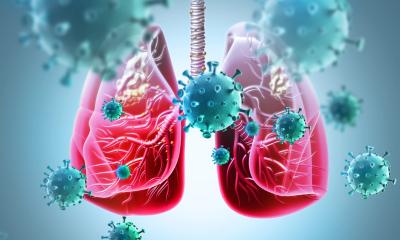Image source: Shutterstock/jovan vitanovski
News • IGF-1
Breast cancer: Growth hormone identified as probable cause
A growth hormone called insulin-like growth factor-1 (IGF-1) is likely to play a role in the development of breast cancer, according to new research.
IGF-1 is already known to encourage the growth and proliferation of cancer cells. Now, two analyses of information from several hundred thousand women enrolled in the UK Biobank study have shown that not only is there an association between higher levels of IGF-1 circulating in the blood and the development of breast cancer, but also, for the first time, that IGF-1 is likely to be a cause of the disease.
The research was published in the leading cancer journal Annals of Oncology.
Researchers from the International Agency for Research on Cancer (IARC), Lyon, France, and the Cancer Epidemiology Unit at the University of Oxford, UK, carried out two, complementary studies to investigate the role of IGF-1 in breast cancer development. The first looked at the associations between levels of IGF-1 in the blood and the chances of the disease developing in 206,263 women. The second study used a technique called Mendelian randomisation to analyse data from 265 variants of genes (single nucleotide polymorphisms or “SNPs”) known to be associated with IGF-1 concentrations in 122,977 cases of breast cancer and 105,974 women without cancer (the controls). In this analysis, the researchers also looked at four SNPs for insulin-like growth factor-binding protein-3 (IGFBP-3), which may modulate the availability of IGF-1.
Mendelian randomisation uses complex statistical analysis of data from large population studies, such as UK Biobank, to provide evidence for cause and effect, rather than just the existence of an association. Randomly inherited genetic variations that alter levels of IGF-1 and IGFBP-3 mimic the effect of a randomised trial and are unaffected by the disease process, so the researchers were able to use them to see whether people with a different genetic make-up had a different risk of breast cancer.
During an average of seven years of follow-up, 4,360 cases of breast cancer occurred. Among the 206,263 women included in the observational analysis, levels of IGF-1 ranged between an average of around 14 nanomoles per litre of blood (nmol/L) among participants with levels in the lowest 20% and 29 nmol/L in the top 20%.

Image source: Emw, Protein IGF1 PDB 1bqt, CC BY-SA 3.0
In the observational study, the researchers found that women with IGF-1 concentrations in the top 20% had 1.24-fold increased chance of developing breast cancer compared to those in the bottom 20%, after adjustments for various factors that could affect the results, such as age, physical activity, body mass index, alcohol consumption, smoking, educational level and concentrations of other hormones and proteins in the blood, such as C-reactive protein, and testosterone. For every 1,000 women in the study who had the lowest IGF-1 concentrations, 21 were diagnosed with breast cancer over the study period, while 26 were diagnosed among those who had the highest concentrations. Every additional 5 nmol/L of IGF-1 concentrations was associated with a 1.11-fold increased risk. The results were consistent for both pre- and post-menopausal women.
Results from the Mendelian randomisation study were similar. For every additional genetically predicted 5 nmol/L of IGF-1, the risk of breast cancer increased by 1.05. However, when the researchers looked at oestrogen receptor positive (ER+) and negative (ER-) breast cancers separately, IGF-1 was only associated with an increased risk of ER+ breast cancer. For every additional 5 nmol/L of IGF-1, there was a 1.06-fold increased risk of ER+ breast cancer. No association was found for IGFBP-3 concentrations and breast cancer risk.
Dr Neil Murphy, a scientist at IARC, said: “We found that higher levels of IGF-1 circulating in the blood, as determined by blood measurements and genetic markers, were related to higher breast cancer risk. These results support a probable causal role of the IGF pathway in breast cancer development.”
Our next step is to gain a fuller understanding of which lifestyle practices can alter IGF-1 concentrations and, in turn, the chances of breast cancer developing
Marc Gunter
Dr Marc Gunter, scientist and head of the nutrition and metabolism section at IARC, said: “To our knowledge, this is largest single study and the first Mendelian randomisation study to examine the relationship between IGF-1 and breast cancer. Importantly, our Mendelian randomisation analyses yielded strikingly similar positive associations between IGF-1 and breast cancer as those found in our observational analyses. Taken together, these results provide the strongest evidence to date for a causal role of the IGF-pathway in breast cancer development, and suggest that altering IGF-1 levels through diet and lifestyle or pharmacological means may be an effective strategy in the primary prevention of breast cancer. Our next step is to gain a fuller understanding of which lifestyle practices can alter IGF-1 concentrations and, in turn, the chances of breast cancer developing.”
Dr Anika Knüppel, a nutritional epidemiologist at the University of Oxford, said: “The association between IGF-1 and breast cancer was first investigated in the 1980s and our findings are in line with various studies since then. But clarifying the direction of the association using Mendelian randomisation in our study leads the way for research into how the IGF-1 pathway can be harnessed in breast cancer prevention.”
It may be possible to modify IGF-1 concentrations in the blood through changes to the amount and types of protein in a person’s diet. In addition, drugs that target the IGF-1 system have been developed. There may be other, as yet unknown factors that can affect IGF-1 concentrations too. Dr Murphy said: “Although levels of IGF-1 in the blood are potentially modifiable it is currently unknown how long an intervention aimed at altering IGF-1 concentrations would have to be applied in order to have a measurable effect or whether there could be other adverse impacts of such an intervention.”
Limitations of the study include the possibility that a different biological pathway may be involved in the effect of IGF-1 on breast cancer, although the researchers conducted various analyses to test this.
Source: European Society for Medical Oncology (ESMO)
11.03.2020











